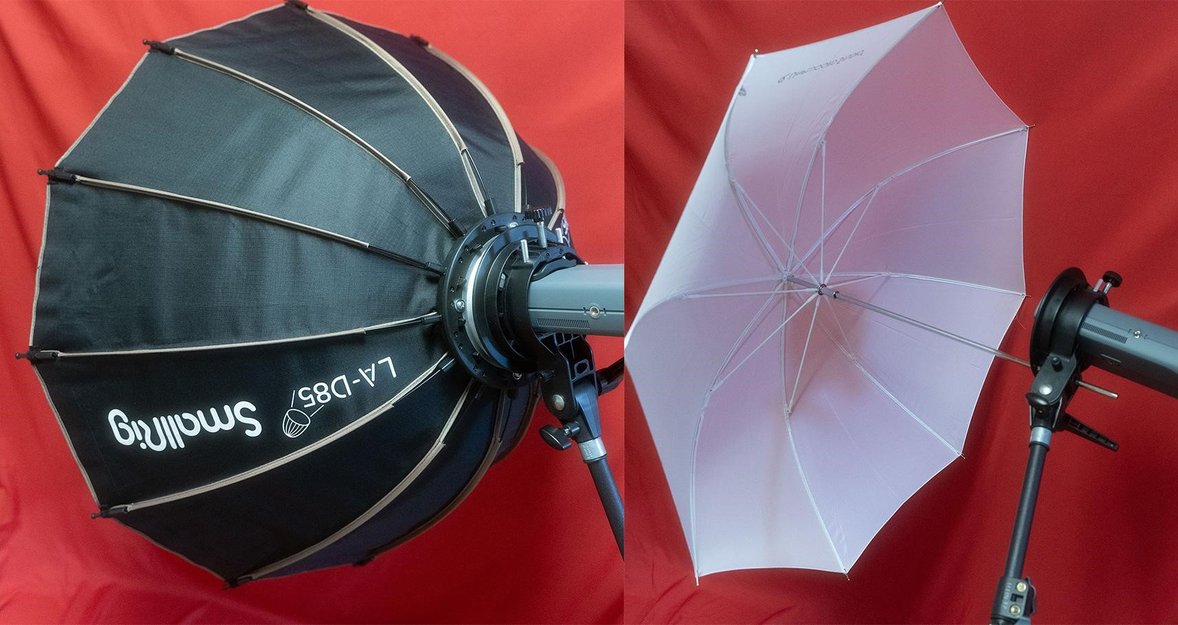Softbox vs Umbrella: Which One Should You Use
July 17, 2024

Explore the differences between a softbox and an umbrella in photography, and learn how to choose the right one for your lighting needs to enhance your photos.
A softbox or umbrella is often used when taking pictures with a flash, particularly with a monoblock strobe that is remotely controlled by a radio transmitter, as opposed to a clip-on flash that attaches directly to the camera. You might wonder, what exactly is the difference between a softbox and an umbrella, and which one should you choose? In this article, I'll explain how these two differ and how to use them effectively.
Advanced yet easy-to-use photo editor
Get Luminar Neo NowWhy Use a Softbox or Umbrella
The primary reason is to enhance the quality of your photos. A flash uses electricity to generate light, which supplements the natural lighting in a scene. However, the light produced by a flash is typically very harsh and directional, which can be unflattering in many photographic situations. To mitigate this, photographers use a softbox or umbrella to modify the light's characteristics.
Softboxes
 First, let's discuss the characteristics of a softbox. Softboxes come in a variety of shapes. The most common type features a rectangular opening, but there are also models with polygonal openings that are nearly circular, similar to umbrellas. A softbox is attached so that the flash's light-emitting part faces the opening, which is covered by a white cloth diffuser to soften the light.
First, let's discuss the characteristics of a softbox. Softboxes come in a variety of shapes. The most common type features a rectangular opening, but there are also models with polygonal openings that are nearly circular, similar to umbrellas. A softbox is attached so that the flash's light-emitting part faces the opening, which is covered by a white cloth diffuser to soften the light.
Umbrellas
As suggested by the name, an umbrella is characterized by its umbrella-like shape. However, "umbrella" is a general term for two types of accessories that, despite having the same shape, are used for different purposes. One type is the reflective umbrella, where the flash is positioned inside the umbrella, and the light is reflected towards the subject.
The other type is the transmissive umbrella, which is placed in front of the flash's light-emitting part, allowing the light to pass through and directly illuminate the subject.
Although these accessories share the name "umbrella," reflective and transmissive umbrellas serve completely different functions
How to Use a Softbox and Umbrella Properly
Next, let's explore the purposes for using softboxes and umbrellas. When light is diffused, it becomes softer.
It's important to understand the quality of light first. If you aim for a natural look, you need to "soften" the quality of the light.
"Hard light" directs the light straight from the flash onto the subject, resulting in harsh, midsummer-sun-like illumination with stark contrasts between light and shadow areas. To achieve a more natural finish, the flashlight should not be aimed directly at the subject but rather provide "soft light." Thus, the light emitted from the flash's light-emitting part is "diffused." There are two main ways to diffuse light: one is by passing the light through a cloth called a diffuser, and the other is by reflecting it. The primary purpose of softboxes and umbrellas is to diffuse this light.
Using a Softbox to Increase Light Directivity
A softbox is primarily used to increase the directivity of light. While the characteristics of light emitted from a flash can vary depending on the flash model, typically, the light is emitted directly in front of the light-emitting part. Although the light does spread out somewhat diffusely, in photography, you often want to concentrate the light on your subject for more focused illumination.
In scenarios like this, a softbox is invaluable as it allows you to direct light precisely onto your subject. Below, I’ll detail this with examples.
Direct Lighting
Here is an image where the light shines directly from the side of the subject. Notice the strong shadow on the subject itself and a pronounced shadow on the background. This setup highlights the impact of unmodified flash lighting.
The light from the flash spreads primarily to the front.
Softbox
This image demonstrates the effect of using a softbox. With the softbox, the light becomes directional, meaning that areas in front of the flash that are blocked do not get illuminated. As a result, although the same amount of light is used, the subject appears brighter due to the focused light. Additionally, the shadows are softer because the light is both reflected and diffused within the softbox, creating a more flattering and less harsh lighting effect.
Using a Reflective Umbrella to Spread Light
A reflective umbrella is chosen when the goal is to spread the light more evenly across the scene. The light-emitting part of the flash is directed towards the inside of the umbrella, away from the subject. The light then reflects off the umbrella’s surface and is redirected towards the subject. This technique not only spreads the flash light over a wider area but also softens it by the additional reflection.
The transition from light to shadow is smoother than with direct lighting or when using a softbox. However, because the flash fires in the opposite direction, the overall intensity of the flash is diminished, despite using the same amount of flash output. To counteract this, you can adjust the camera settings or increase the flash’s power to achieve a brighter image.
Exclusive Tools of Endless Possibilities in One AI Editor
EXPLORE NOW!Using a Transmissive Umbrella for Soft, Diffused Light
A transmissive umbrella is used when you aim to direct the flash light towards the umbrella and allow it to pass through a translucent material, thus diffusing the light and creating an overall softer effect.
As illustrated in the example, the light envelops the scene from the front. The passing of the light through the umbrella ensures that the shadows are exceptionally soft, arguably the softest compared to other lighting modifiers. Although the light intensity from the flash is somewhat reduced due to the translucent material, it remains brighter than what is typically achieved with a reflective umbrella.
Should I Buy a Softbox or an Umbrella: Quick Recap
Softboxes and umbrellas may look similar at first glance, but they serve different purposes. Here's how to decide which one to choose based on your specific needs:
Softbox
Focused Light: If you want to concentrate light on the subject, a softbox is ideal. It allows you to direct light more precisely, making it perfect for highlighting the subject while keeping the background darker.
Diffused Light: Softboxes are often equipped with one or two diffusers that soften the light. This helps create a softer, more flattering light on the subject.
Versatility: Softboxes are highly versatile and are a standard flash accessory for many shooting scenes requiring controlled lighting.
Assembly: One downside is that softboxes require a special mount to attach to the flash and can be more cumbersome to set up and transport, especially on location shoots.
Reflective Umbrella
Even Illumination: Use a reflective umbrella when you want to diffuse light and illuminate the entire area, not just the subject.
Ease of Use: Reflective umbrellas are easy to use. Simply open the umbrella and attach it to the flash using an umbrella holder. This makes them convenient for quick setups and location shoots.
Soft Light: Umbrellas can also soften light effectively. You can add a diffuser to the opening to enhance this effect. However, this can reduce the amount of light, so it's important to consider the power of your flash.
Transparent Umbrella
Simplicity: A transparent umbrella is the easiest to use and is ideal for beginners. It requires no assembly—just insert it into a holder.
Soft Light: While it softens light to a certain extent without needing an additional diffuser, it may not provide the same level of softness as a softbox or reflective umbrella with a diffuser.
Portability: Transparent umbrellas are compact and lightweight, making them perfect for travel and quick setups. They are a good starting point for learning about flash photography.





